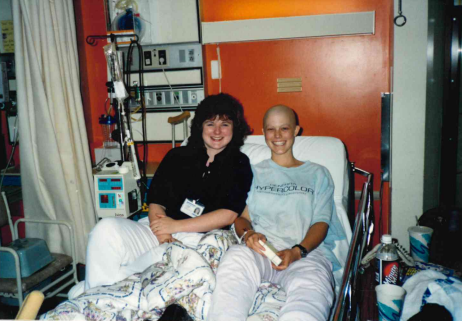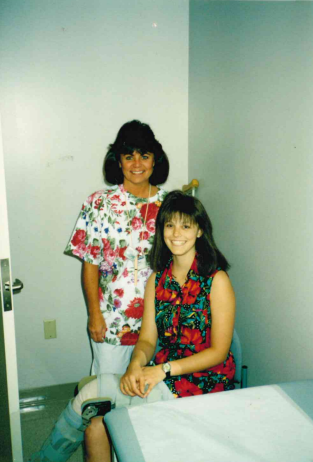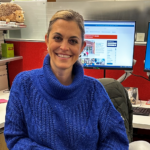PART FOUR: From witnessing exceptional care and compassion given to children in their own lives, to receiving treatment first-hand, this weekly series features Seattle Children’s employees and the life experiences that drove them to pursue careers in healthcare.

In 1991, Becky Greenway was a 17-year-old student facing chronic knee pain throughout her senior year of high school.
“My pain was worse at night and the only way I could get any relief was by soaking it in the bathtub,” she recalled.
Greenway sought care from several primary care doctors who provided varying diagnoses, including tendonitis, growing pains and a possible mental disorder.
“This fourth doctor couldn’t find any reason for my pain, so he was convinced it was all in my head,” Greenway explained.
Feeling exasperated, Greenway’s mother pushed forward, certain that the root of her daughter’s pain was something more serious.
“I was finally seen by an orthopedic surgeon who immediately noticed a shadow on my X-rays,” she said. “Convinced this was a tumor, he sent me to see Dr. Ernest ‘Chappie’ Conrad, a former physician at Seattle Children’s.”
Within days, Greenway was being evaluated by Chappie and other experts from the Orthopedics and oncology teams- both internationally regarded for their program excellence.

For more than a decade, U.S. News & World Report has designated Seattle Children’s Orthopedics and Sports Medicine Program among the top pediatric orthopedic programs in the country. Additionally, Seattle Children’s Cancer and Blood Disorders Center is recognized globally for its expertise in care, research and innovative treatments for children with cancer and blood disorders, and leads the largest pediatric oncology consortium in the world.
“They suspected that I had a benign tumor that needed to be resected, so I was scheduled for surgery the following week,” Greenway explained. “The team planned to remove the tumor, which had already ‘eaten’ through about half of my tibia, and replace it with donor bone from my hip.”
In preparation, doctors ordered an MRI the day prior to the surgery. It was a day that Greenway will never forget.
“I can say that the course of my life changed that day after returning home,” she recalled. “Chappie called my parents that night and told them the MRI results showed that this may actually be a malignant mass, and not the benign tumor they were expecting.”
Though the difficult news altered the next day’s plan slightly, the surgery would still move forward.
“They would open my leg up, take a surgical biopsy and wait for the results,” Greenway said. “If the biopsy returned as a benign growth, the surgeons would take the tumor out and replace the area with donor bone. If the biopsy results showed a malignancy, they would close me right back up, insert a Hickman line and start chemotherapy.”
A central line is an IV (intravenous) line that is surgically placed into a large (central) blood vessel of the body. Two very common types of central lines are called Hickman and Broviac catheters. Chemotherapy uses medicines to kill cancer cells. The most current chemotherapies are provided at Seattle Children’s, including promising new medicines offered only in clinical trials.
“The next couple months were a blur for me,” Greenway said. “I do remember waking up that next day on the teen floor with a line coming out of my chest and teary-eyed family surrounding my bed. With only a 60% chance of survival over the following five years, I knew I was in for the fight of my life.”
For the next three months, Greenway had intense, inpatient chemotherapy to kill the cancer cells and ultimately enable doctors to resect the tumor.
“After the initial three months, I went back into surgery to have the tumor removed and everywhere it touched,” she explained. “This included removing my Fibula and proximal Tibia, which included part of the knee and replacing the Tibia with a donor bone.”

The surgery and recovery process was a lengthy and painful one. Unfortunately, when the results came back, the biopsy showed that the tumor had only been 50% destroyed. Greenway was given another nine months of inpatient chemotherapy and it was the beginning of multiple leg surgeries. In 2001, Greenway was considered cancer free.
11 years later, after focusing on family and raising two children, Greenway decided that she was ready to join the workforce — and knew exactly where she wanted to start.
“Because of the exceptional care I received and the dedication to patients and families, the first thing I did was look at Seattle Children’s Career Center,” she explained.
Greenway joined Seattle Children’s as an administrative assistant in The Department of Nursing Practice, Professional Development and Innovation and is now supervisor of Clinical Services Administration. She is proud to be able to give back to the people and organization who gave her the gift of life and extra years with the ones that she loves.

“I have two beautiful, compassionate daughters who I am so grateful for,” Greenway shared. “I am beyond blessed and will be forever indebted to Seattle Children’s. When no one else knew how to treat me, Seattle Children’s was there. This community of angels not only saved my leg, but also my life.”
“I was able to not only raise my children, but also run, play and hike with them. I can LIVE a wonderful life with them and make beautiful memories because of the dedication and brilliance that is Seattle Children’s.”
Resources:
- Orthopedics and Sports Medicine – Seattle Children’s (seattlechildrens.org)
- Cancer and Blood Disorders Center – Seattle Children’s (seattlechildrens.org)
- Careers – Seattle Children’s (seattlechildrens.org)
- I Know What it Feels Like’ | Meagan’s Journey – On the Pulse (seattlechildrens.org)
- ‘Cancer Doesn’t Always Win’ | Sofia’s Personal Connection to “Hope. Care. Cure.” (seattlechildrens.org)
- How Johanna’s Unique Experience Drove Her to Healthcare (seattlechildrens.org)

